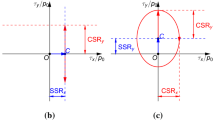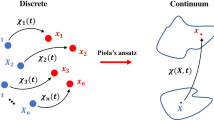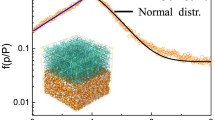Abstract
The dynamics of grain fabrics is captured by means of a hidden state variable , named eutaraxy, which quantifies the propensity for a heat-like micro-seismicity due to disturbing actions. Its increase by driving and decrease by halting are captured by an evolution equation with switch functions. The specific elastic energy depends on the elastic strain and the void ratio so that a Coulomb condition and a maximal void ratio denote critical points. The rate-independent evolution equation of the elastic strain tensor implies a micro-seismically activated relaxation. Monotonous deformations lead to a hypoplastic response, and thereafter isochoric ones tend to steady states . The hysteresis of repeated reversals, which requires rate-independence and stability, is captured without further parameters, and likewise the accumulation of anelastic strain by cycles with small amplitudes. The parameters are physically defined and can be calibrated by means of triaxial tests. Limitations and possible extensions are outlined.













Similar content being viewed by others
Abbreviations
- \(D_r\equiv (e_{\max }-e)/(e_{\max }-e_{\min })\) :
-
Relative density via void ratio e
- \(\sigma '_{ij}\) :
-
Fabric or effective stress tensor
- \(p'\equiv \frac{1}{3}\sigma '_{ii}\) :
-
Mean fabric pressure
- \(\epsilon _{ij}\) :
-
Strain tensor with amount \(\epsilon \equiv \sqrt{\epsilon _{ij}\epsilon _{ij}}\ll 1\) and volumetric strain \(\epsilon _v\equiv \epsilon _{ii}\)
- \(\epsilon ^{e}_{ij}\) :
-
Elastic strain tensor with volumetric and deviatoric invariants \(\epsilon ^{e}_v\) and \(J^{e}_2\)
- \(w_e(\epsilon ^{e}_v,J^{e}_2, D_r) \) :
-
Specific elastic energy stiffness and friction factors \(B_d\) and b
- \(\sigma ^{e}_{ij}\equiv \partial w_e/\partial \epsilon ^{e}_{ij}\) :
-
Elastic stress tensor with first and second invariants \(p^{e}\) and \(\bar{\tau }^{e}\)
- \(\alpha , \alpha _h\) :
-
Transfer factor and its hypoplastic upper bound
- \(\chi , \chi _h\) :
-
Eutaraxy and its hypoplastic upper bound
- \(c_{\chi }, \chi _a, \epsilon _r\) :
-
Factor and auxiliary variables for the evolution of \(\chi \)
- \(\lambda _v/\lambda _d\) :
-
Ratio of volumetric and deviatoric relaxation factors, factor \(c_{\lambda }\) for it.
References
Behringer RP, Chakraborty B, Clark A, Dijksman J, Ren J, Zhang J (2014) Statistical properties of granular materials near jamming. J Stat Mech: Theory Exp 6:P06004
Chang C, Whitman V (1988) Drained permanent deformation of sand due to cyclic loading. J Geotech Eng Div ASCE 114(10):1164–1180
Gudehus G (2011) Physical soil mechanics. Springer, Berlin
Gudehus G, Jiang Y, Liu M (2010) Seismo- and thermodynamics of granular solids. Granul Matter 13(4):319–340
Gudehus G, Touplikiotis A (2016) Wave propagation with energy diffusion in a fractal solid and its fractional image. Soil Dyn Earthq Eng 89:38–48
Gudehus G, Touplikiotis A (2017) On the stability of geotechnical systems and its fractal progressive loss. Acta Geotechnica 13(4):1–12
Hardin BO, Drenevich VP (1972) Shear modulus and damping in soils: design equations and curves. J Soil Mech Found Div ASCE 98(SM7):667–692
Huber G, Wienbroer H (2005) Vibro-viscosoity and granular temperature of cylindrical grain skeletons: experiments. Powder Grains 1:287–290
Jiang Y, Liu M (2007) A brief review of ‘granular elasticity’. Eur Phys J, E 22:255–260
Jiang Y, Liu M (2009) Granular solid hydrodynamics. Granul Matter 11:139–156
Jiang Y, Zheng H, Zheng P, Fu L, Song S, Sun Q, Maye M, Liu M (2012) Expression for the granular-elastic energy. Phys Rev, E 85(051304):1–9
Jiang Y, Liu M (2013) Proportional paths, barodesy and granular solid hydrodynamics. Granul Matter 15:237–249
Kolymbas D (2012) Barodesy: a new hypoplastic approach. Int J Numer Anal Methods Geomech 36(9):1220–1240
Kondic L, Behringer LP (2004) Elastic energy, fluctuations and energy for granular materials. Europhys Lett 67(2):205–211
Mandelbrot B (1982) On the fractal geometry of nature. Freeman, New York
Mokni M, Desrues J (1998) Strain localization measurements in undrained plane-strain biaxial tests on Hostun RF sand. Mech Cohesive-Frict Mater 4:419–441
Niemunis A, Wichtmann T, Triantafyllidis T (2005) A high-cycle accumulation model for sand. Comput Geotech 32:245–263
Niemunis A, Prada-Sarmiento LF, Grandas-Tavera CE (2011) Paraelasticity. Acta Geotechnica 6:67–80
Niemunis A, Wichtmann T (2014) Separation of time scales in the HCA model for sand. Acta Geophys 62(5):1127–1145
Rowe PW (1972) Theoretical meaning and observed values of deformation parameters for soil Stress-strain behaviour of soils. In: Parry RHG (ed) Proceedings of Roscoe Memorial Symposium. GT Foulis, Henley-on Thames, pp 143–194
Shahinpoor M, Sharpass A (1982) Frequency distribution of void in monolayers of randomly packed equal spheres. Bull Solids Handl 2(4):825–837
Truesdell C, Noll W (1965) The non-linear field theories of mechanics. Encyclopedia of physics, III/c. Springer, Berlin
Verdugo R, Ishihara K (1996) The steady state of sandy soils. Soils and Foundations 36(2):81–91
Visintin A (1991) Differential models of hysteresis. Springer, Berlin
Wichtmann T (2016) Soil behaviour under cyclic loading-experimental observations, constitutive description and applications. Veröffentl. Inst. Bodenmech. Felsmech. am KIT, Heft, p 181
Wichtmann T, Niemunis A, Triantafyllidis T (2006) Experimental evidence of a unique flow rule of non-cohesive soils under high-cyclic loading. Acta Geotechnica 1:59–73
Acknowledgements
I owe valuable hints to Roberto Cudmani (Munich), Gerhard Huber (Karlsruhe), Demetrios Kolymbas (Innsbruck), Mario Liu (Tübingen), Andrzej Niemunis (Kalsruhe) and Torsten Wichtmann (Weimar). This is gratefully acknowledged.
Author information
Authors and Affiliations
Corresponding author
Additional information
Publisher's Note
Springer Nature remains neutral with regard to jurisdictional claims in published maps and institutional affiliations.
Rights and permissions
About this article
Cite this article
Gudehus, G. Granular solid dynamics with eutaraxy and hysteresis. Acta Geotech. 15, 1173–1187 (2020). https://doi.org/10.1007/s11440-019-00820-y
Received:
Accepted:
Published:
Issue Date:
DOI: https://doi.org/10.1007/s11440-019-00820-y




